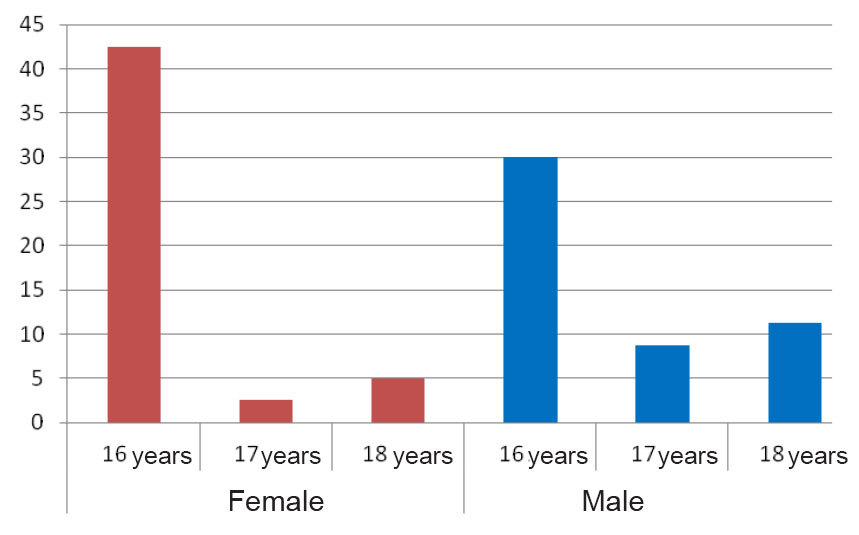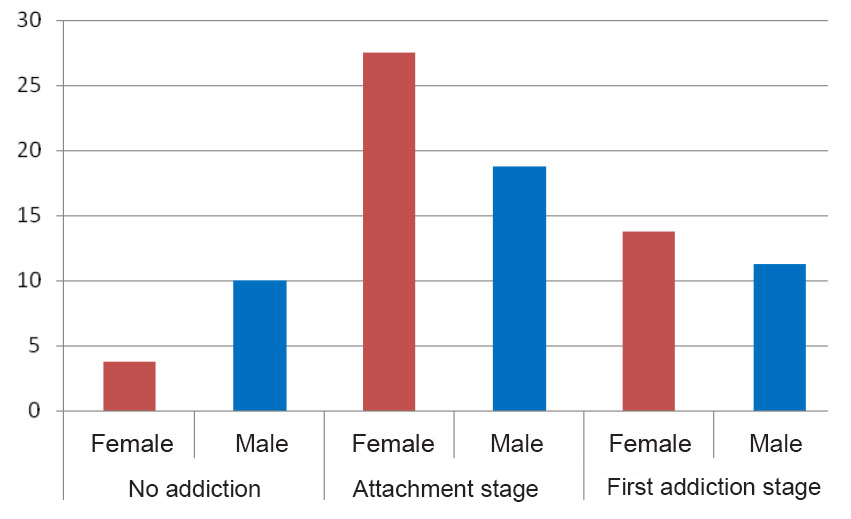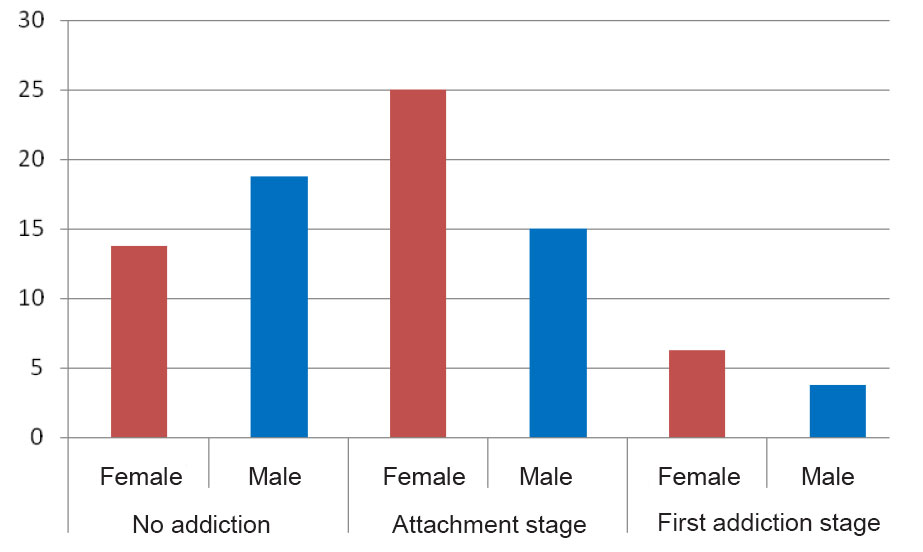Computer addiction control model in application to physical education college students
Фотографии:
ˑ:
Dr.Hab., Associate Professor E.A. Cherepov1
PhD, Associate Professor G.K. Kalugina1
A.S. Khafizova1
O.V. Melnikova1
1South Ural State University (National Research University), Chelyabinsk
Keywords: computer addiction, computer addiction screening tests, college students.
Background. Despite the growing popularity of computer technologies in different population groups and their benefits for many cognitive missions and psychological support purposes, there exist quite a few health risks associated with computer games and internet addiction, particularly for the underage and adolescent population groups [1, 2, 5, 6].
Computer addiction is ranked today among the most common health disorders and is generally diagnosed as the virtual reality addiction at sacrifice of the everyday life and responsibilities associated with transformations in the individual emotional balances and mindsets. As reported by Russian psychologists, 10 to 14 percent of people playing computer games have an unhealthy addiction; whilst American analysts report the game addiction rates varying from 40 to 80 percent, with virtually every age group being at risk, particularly the adolescent one [7, 9].
Objective of the study was to rate the computer addiction in Chelyabinsk Physical Education College students and find ways to control/ mitigate the addiction.
Methods and structure of the study. The study was performed in September through December 2017 at Chelyabinsk Physical Education College of South Ural State Physical Education University. Subject to the study were the 16-18 year-old first-year students (n=80) majoring in Physical Education, Adaptive Physical Education and Tourism. The sample was tested by the Computer Dependence Screening diagnostics method by L.N. Yuryeva and T.Yu. Bolbot [8].
Furthermore, we applied the relevant information and employment technologies for the primary addiction prevention purposes in the computer addiction control course of our own design. The information technologies were intended to improve the students’ competency in a few critical fields including interpersonal relationship building culture, communication technologies, stress coping methods, and addictive behaviour control tools. For the therapeutic and corrective purposes, the sample was trained twice a week to offer the personality growth models customized to correct the negative personality trends and behaviour and to cultivate the self-development skills and motivations in the students [2, 4]. Given in Table 1 hereunder are the applied training games and practices.
Table 1. Training games and practices applied to correct the negative personality trends and behaviour
|
Game, practice |
Goals of the game/ practice |
|
Shipwreck |
Reflections, constructive behaviour, conflict settlement through game, interpersonal communication skills building |
|
Rear view |
Teamwork, people management skills, executive skills |
|
Molecules |
Group relaxation |
|
Piece of ice |
Teamwork, removing interpersonal barriers |
|
Who am I? My physical self |
Reflective capacity building, own qualities and habits analyzing skills |
|
Who am I? My personality |
Reflective capacity building, self-analyzing skills |
|
Reincarnation |
Goal setting, problem-solving skills building |
|
Elephant |
Stress control, emotional uplift, group activation skills |
|
Digicon game |
Societal perception skills; responsibility for own decisions; uniting and team building skills; teamwork benefits acknowledgement; stress coping skills; leadership development and demonstration practices |
|
Statue shaping |
Mutual trust, verbal and nonverbal communication skills |
|
Ark |
Teamwork, nonverbal communication skills |
The employment technologies applied under the study included club activity in academic sport groups (training twice a week) to cut short the leisure time and gradually increase the tasks to keep the students busy and attentive. In addition, the students were offered extreme sports (mountaineering), rifle shooting, trampoline practices and paintball club activities.
Study results and discussion. Given on Figure 1 hereunder is the age and gender structure of the sample.

Figure 1. Age and gender structure of the sample, %
By the academic specialties the sample (n=80) is classified as follows: 66.25% major in Physical Education; 21.25% in Adaptive Physical Education; and 12.5% in Tourism.
The pre-experimental computer addiction tests showed only 13.75% of the sample (8 male and 3 female students) being totally free of a computer addiction, despite the fact that 70% of the sample reported going in for some active sports. The rest of the sample was provisionally ranked with the risk group diagnosed with computer addictions varying from the primary attachment stage to the first addiction stage in need of special health rehabilitation actions: see Figure 2. It may be pertinent to mention that these data fall at variance with some other studies that report the male adolescents being 10 times more exposed to the computer addiction than their female peers [1, 3, 5].

Figure 2. Pre-experimental gender-specific computer addiction rates, %
The following mental symptoms of a computer addiction were tested in 87.5% of the sample:
– Good mood or euphoria when using computer reported by 100% of the sample;
– Inability to stop reported by 63.7%;
– Growing computer usage time reported by 62.5%;
– Growing indifference to family and friends reported by 56.3%;
– Growing fatigue, depression, irritation when sitting at computer reported by 61.2%;
– Lies to family on the computer business reported by 17.5%; and
– Problems at work or university due to the computer addiction reported by 36.3%.
The following physical symptoms of a computer addiction were tested in 70% of the sample:
– Carpal canal syndrome i.e. the nerve trunk disorder in the mouse-control hand reported by 11% of the sample;
– Dry eyes symptom reported by 10% of the sample;
– Dorsal pains reported by 36%;
– Irregular nutrition, meal skipping reported by 19%;
– Growing negligence to hygiene reported by 2.5%; and
– Sleeping disorders, changes in the habitual sleeping hours reported by 31% of the sample.
Upon completion of the computer addiction control training course, the sample was tested once again. The classified post-experimental gender-specific computer addiction rates are given in Figure 3 hereunder.

Figure 3. Classified post-experimental gender-specific computer addiction rates, %
As demonstrated by the above data, the computer addiction correction course resulted in the numbers of the addicted (Stage 1) female and male population falling two and three times, respectively: see Figure 3. The time wasted online was reported to fall too. The preventive activities helped cut down the share of the students spending 3-plus hours a day online from 88.8% to 62.5%; and the share of the students sitting in chat applications from 56.3% to 42.5%. The shares of the first-year students diagnosed with mental and physical symptoms of a computer addiction were tested to fall by 25% and 10%, respectively.
Conclusion. The study found the students engaged in active sports being less exposed to a computer addiction. Special trainings, active games and practices, club activity, group sport trainings (twice a week) and active recreation models intended to facilitate the personality progress and correct some negative personality traits and behavioural standards were found beneficial for the initiatives to control and mitigate the computer addiction in the Physical Education College students.
References
- Volkova E.N., Grishina A.V. Struktura sub'ektnosti mladshikh podrostkov s raznym urovnem igrovoy kompyuternoy zavisimosti [Structure of subjectivity of preteens with different levels of computer game addiction]. Psikhologicheskiy zhurnal, 2015, vol. 36, no. 2, pp. 20-31.
- Voronov D.I. Kompyuternaya zavisimost i sotsialno-psikhologicheskie zakonomernosti ee proyavleniya [Computer addiction and socio-psychological patterns of its manifestation]. Vestnik Cherepovetskogo gosudarstvennogo universiteta, 2013, vol. 2, no. 3 (50), pp. 167-171.
- Soldatkin V.A., Dyachenko A.V., Mavani D.Ch. Kontseptsii formirovaniya kompyuternoy zavisimosti [Concepts of formation of computer addiction]. Sotsialnaya i klinicheskaya psikhiatriya, 2013, vol. 23, no. 3, pp. 104-110.
- Syropyatov O.G., Dzeruzhinskaya N.A., [Bukhanovsky A.O.] Psikhoterapiya: teoriya i praktika. Ucheb. posobie [Psychotherapy: theory and practice. Study guide]. Rostov-on-D.: Fenix pupl., 2012, 445 p.
- Fadeeva S.V. Psikhologo-pedagogicheskie aspekty kompyuternoy zavisimosti podrostkov [Psychological and pedagogical aspects of computer addiction among adolescents]. Vospitanie shkolnikov, 2009, no. 10, pp. 23-25.
- Cherepov E.A. Metapredmetnaya paradigma zdorovyeformiruyuschego obrazovatelnogo prostranstva sovremennoy obscheobrazovatelnoy organizatsii [Meta-Subject paradigm of health-forming education space in modern general education institution]. Vestnik YuUrGU. Ser. Obrazovanie, zdravookhranenie, fizicheskaya kultura, 2015, vol. 15, no. 4, pp. 5-13.
- Shmelev A.G. Kompyuternoe testirovanie znaniy u studentov-psikhologov [Computer testing for students-psychologists]. Vestnik Moskovskogo universiteta. Ser. 14: Psikhologiya, 2003, no. 1, pp. 35-48.
- Yuryeva L.N., Bolbot T.Yu. Kompyuternaya zavisimost: formirovanie, diagnostika, korrektsiya i profilaktika [Computer addiction: building, diagnostics, correction and prevention]. Dnepropetrovsk: Porogi publ., 2006, 196 p.
- Orzack M.H. How to recognize and treat computer.com addiction. Clin. Counseling Psychol., 1999, vol. 9, pp. 124-130.
Corresponding author: cherepov.e@mail.ru
Abstract
The study analyzes problems of the first-year students’ computer addiction based on the addiction screening tests of the 16-18 year-old college students (n=80) majoring in Physical Education, Adaptive Physical Education and Tourism; and considers the negative effects of the computer addiction on the students’ physical and mental health. Based on the study data and analyses, we offered a set of information and employment technologies designed to prevent/ mitigate the computer addiction at early stages. The applied information technologies were geared to improve the young people’s competency in a few specific fields including interpersonal communication culture, communication technology, stress coping methods and solutions to addictive behaviour related problems. The applied employment technologies were intended to offer them club/ group sports services (twice a week), reduce leisure time and offer time- and attention-intensive practices, including a range of extreme and shooting sport practices. The new training course was found beneficial as verified by the tested reduction of the computer addiction and improvement of the physical fitness rates in the sample.




